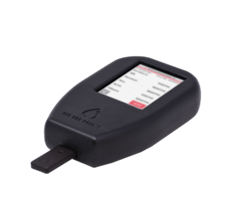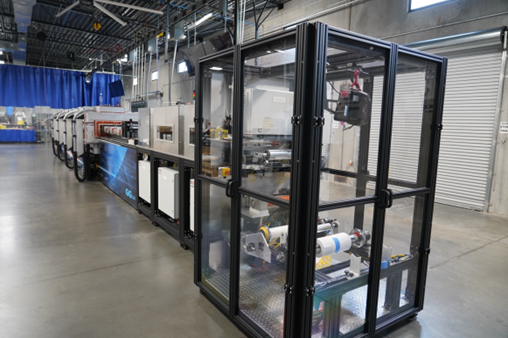The COVID-19 pandemic posed a formidable challenge to global healthcare, exposing significant shortcomings in advanced medical infrastructure and dependable testing tools, resulting in the unchecked spread of the virus worldwide.
Image Credit: General Graphene Corporation
One of the leading issues highlighted during the pandemic was the capacity for precise COVID-19 detection in point-of-care settings.
Although industry rapidly deployed various point-of-care lateral flow devices (LFAs) in response to the pandemic, the limited sensitivity and selectivity of these devices hindered their accuracy and reliability in curbing the virus’s spread.
Most airlines requiring negative COVID-19 test results before departure insisted on PCR tests, given the inaccuracies and unreliability of point-of-care lateral flow devices.
The unreliability of these point-of-care devices shifted market perception toward PCR as the preferred diagnostic method. However, PCR presents its own challenges – including the inability to be deployed at point-of-care, the requirement for extensive sample preparation, and signal amplification.
The need was evident: diagnostic tests needed to be deployable across point-of-care settings while maintaining the necessary accuracy to manage infectious disease outbreaks effectively.
Why Graphene?
Graphene is a versatile platform material situated at the convergence of biology and technology, showing promise for integration into various biosensing platforms.
Biosensor platforms function as portable electrochemical devices, gauging biomolecule interactions by producing signals upon introducing a target biomolecule recognition element, such as antibodies, enzymes, proteins, viruses, and aptamers.
Graphene-based biosensors, operating as “lab-on-a-chip” devices, offer significant advantages in speed, precision, and point-of-care applicability, making them a distinct solution for addressing significant healthcare challenges.
Graphene’s ability to rapidly detect various biomarkers with high sensitivity and selectivity positions it to drive significant advancements in early disease diagnosis, personalized medicine, and biomedical research.
Surface chemists or biological surface engineers can functionalize a graphene surface using various biomolecule receptors, including proteins, aptamers, viruses, DNA, RNA, and antibodies.
This wide functionalization potential allows graphene to be employed across various single or multiplexed point-of-care biosensor devices. Atomically thin materials present unique electronic properties owing to the influence of quantum mechanics. Graphene’s distinctive electrical properties enable highly sensitive biomolecule detection in an affinity-based field-effect transistor (FET) device configuration.
Most existing point-of-care diagnostic tools are limited to detection sensitivities on the order of 10-9 or nano levels. Leveraging CVD graphene, General Graphene’s partners have succeeded in developing a range of diagnostic devices offering sensitivities ranging from 10-11 to 10-15 levels, marking an outstanding improvement over traditional point-of-care diagnostic devices and even surpassing PCR at the 10-15 detection limit.
Graphene-based point-of-care diagnostics, with their high signal-to-noise ratio, assure superior selectivity and an extensive range for detecting analyte concentrations. This proves critical in mitigating the prevalence of false positives and false negatives observed in conventional point-of-care tools, ensuring that graphene-based point-of-care diagnostics exhibit accuracy on par with, or surpassing, laboratory-grade diagnostic instruments.
Traditional laboratory-based screening tools often necessitate signal amplification and extensive sample preparation to deliver accurate biomolecule concentration measurements. In contrast, graphene-based point-of-care diagnostics eliminate signal amplification and require minimal sample preparation, significantly reducing the time required for results from days and hours to minutes.
Preparing for the Next Pandemic
If graphene-based point-of-care devices had existed during the COVID-19 pandemic, the described benefits would undoubtedly have played a pivotal role in addressing numerous challenges associated with disease management, potentially leading to better control and containment of the global COVID-19 outbreak.
People would not have had to drive to a PCR testing facility for reliable and accurate testing, reducing the risk of further contamination and potentially aiding in containing the outbreak.
With their high selectivity and signal-to-noise ratio, graphene-based biosensors could also have mitigated the number of false positives and false negatives, enhancing the overall credibility of point-of-care diagnostic platforms.
The ability to provide fast point-of-care detection with results delivered in minutes could also have allowed for timely contact tracing and isolation, significantly reducing the testing backlog that medical providers faced during the pandemic.
The world certainly needs to be better equipped before the next pandemic occurs. Graphene biosensors have the potential to become a critical element in developing improved healthcare technology and infrastructure that can help contain future infectious disease outbreaks.
Graphene’s Impact Beyond COVID-19 Diagnostics
The versatile functionalization potential of graphene means that its potential in point-of-care diagnostic devices extends far beyond COVID-19.
General Graphene Corporation is partnering with GrapheneDx, a developer of novel graphene-based diagnostic platforms.
GrapheneDx’s first device in development is a multiplexed point-of-care device capable of highly sensitive detection of chlamydia and gonorrhea within minutes, expanding the landscape of accurate real-time STD testing beyond clinical settings.

Figure 1. GrapheneDX’s graphene diagnostic platform for multiplexed point-of-care STD testing. Image Credit: GrapheneDX
Hememics Biotechnologies is a partner developing 32-plex graphene biosensor chips that are 100 times more sensitive than lateral flow devices. Their first set of graphene devices are geared towards detecting SEB and ricin at consistent low picomolar range sensitivities with results provided within 5 minutes – providing a field deployable tool for real-time biotoxin detection.


Figure 2. Hememics Biotechnologies’s 32-plex graphene biosensor chip devices. Image Credit: Hememics Biotechnologies Inc.
Beyond diagnostics, graphene-based biosensors can be utilized in real-time environmental monitoring applications, real-time monitoring of vital signs (glucose levels and heart rate), food safety, and agriculture.
They can also be used in biomedical research to measure various biomolecular interactions, including protein-protein interactions, DNA hybridization, and enzyme kinetics.
Graphene’s versatility as a platform material and its immense potential for functionalization make it a promising candidate for biomolecule sensing across various applications.
Its exceptional electrical properties and extensive customization possibilities offer an extensive opportunity for exploration and innovation in this field, driven by the creative thinking and expertise of skilled biological surface engineers.
Scalable Graphene Biosensors
General Graphene believes that to make an impact and be ready for mass adoption, graphene-based solutions must be more cost-effective and superior to existing alternatives.
General Graphene’s industrial-scale CVD graphene manufacturing technology allows it to provide CVD graphene in large volumes, at significantly lower price points, and with tailored qualities for specific applications.
This enables the incorporation of CVD graphene into point-of-care diagnostic tools that are at least 100 times more sensitive and cost-competitive compared to thin film metal substitutes.
By enabling the manufacturing of low-cost point-of-care diagnostics with lab-grade accuracy and rapid results, graphene offers a pathway toward developing a safe and convenient healthcare ecosystem for users and healthcare providers alike.
With General Graphene’s industrial-scale CVD technology and expertise in CVD graphene manufacturing, it can provide a path to collaboratively address the challenges of scaling CVD graphene application development R&D.
This information has been sourced, reviewed and adapted from materials provided by General Graphene Corporation.
For more information on this source, please visit General Graphene Corporation.



